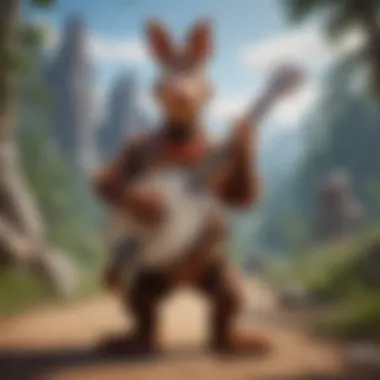Exploring Banjo-Kazooie: A Deep Dive into N64's Classic


Intro
The exploration of Banjo-Kazooie on the Nintendo 64 reveals much about the innovation and creativity that marked the platforming genre of its era. Released in 1998, this game stands as a pillar in video game history. Players experience a rich blend of humor, adventure, and intricate level design. As we navigate through the different sections of this analysis, key elements such as gameplay mechanics, character highlights, and cultural relevance will be discussed.
Core Themes
Understanding this game necessitates a look at its multifaceted nature. Here are some of the primary areas we will delve into:
- The gameplay mechanics that set it apart from others in the genre.
- Character design, which showcases the charm and distinctiveness of Banjo and Kazooie.
- The storyline that drives the players' motivation.
- Visuals and musical composition that enhance the overall experience.
- Cultural impact, looking at both its immediate influence and its legacy in gaming.
With this foundation, readers will gain deeper insight into why Banjo-Kazooie remains an essential title for fans and scholars alike.
Prelude to Banjo and Kazooie
Banjo and Kazooie represents a key moment in the evolution of video games, particularly in the platforming genre. This section aims to provide a foundational understanding of the game, highlighting its initial impact and relevance in today's gaming landscape. The importance of this game extends beyond mere nostalgia; it encapsulates a shift in game design philosophies that prioritize character depth, engaging narratives, and interactive environments.
Overview of the Game and Its Release
Banjo and Kazooie was released on June 29, 1998. This title was developed by Rare, and showcased the capabilities of the Nintendo 64 hardware. Many games prior struggled to create cohesive worlds. However, Banjo and Kazooie offered a colorful, immersive environment filled with intricate level designs. Players could explore these worlds while uncovering secrets and engaging with charming characters. The gameplay mechanics combined platforming with adventure elements effectively, leading to a fresh gaming experience.
Initially, the reception was overwhelmingly positive. Critics praised the graphics and level design, which were exceptional for the time. Additionally, the character dynamics between Banjo, the bear, and Kazooie, the bird, created a unique gameplay experience. Their interactions formed a central element of the narrative. As players progressed, they discovered that collecting items and completing challenges was not just a goal but integral to the overall experience.
Significance in Nintendo's Library
Banjo and Kazooie holds a significant position within the Nintendo library. It is not merely another title but a cornerstone that showcased what platformers could achieve. Its success is evident in the numerous awards it garnered, including high ratings from various gaming publications. The game played a pivotal role in establishing Rare as a leading developer and demonstrated the potential for storytelling in platformers, a concept that many games would follow in subsequent years.
Moreover, the blend of humor, creativity, and challenge set a standard for future Nintendo titles. Players looked beyond mere scores and challenges; they sought immersion. This title inspired many developers to innovate within the genre. A common thread in the evolution of platformers can be traced back to the impact of Banjo and Kazooie. In essence, it is not only remembered as a classic but also appreciated for paving the way for future innovations in game design and narrative structure.
"Banjo and Kazooie not only defined a genre but set the stage for a new era of interactive storytelling in video games."
Development History
The development history of Banjo-Kazooie is a crucial element to understanding its success and significance in the gaming world. This section highlights the creative process, key contributors, and the hurdles the team faced in real-time. By exploring these factors, readers can appreciate not only the artistry of the game but also the dedication and innovation that came together to form this classic title.
Conceptualization and Early Ideas
The journey of Banjo-Kazooie began at Rare, a British video game developer, known for titles that pushed the boundaries of 3D platforming. Initially, the concept was to create a game that would utilize the capabilities of the Nintendo 64, which had recently launched. Developers wanted to combine elements from previous successful titles, crafting a richly detailed world where players could explore and solve puzzles.
As ideas evolved, the game shifted towards a duo protagonist model. Banjo, the bear, would team up with Kazooie, a bird, allowing for distinct movement dynamics and abilities. This blend of character traits was significant, as it created an engaging gameplay strategy. The team focused on developing a vibrant, welcoming universe that captivated a broad range of players.
Key Figures Behind the Creation
Several key individuals played vital roles in the development of Banjo-Kazooie. Among them were Greg Mayles, who originated the concept for the game, and artist and designer, Phil Tossell. Their creative vision laid the groundwork for what would soon become a beloved franchise.
Composer Grant Kirkhope also deserves mention for crafting the game’s iconic soundtrack. His work blended humor and charm, perfectly complementing the visual experience. The collaboration between these creative minds fostered an environment where innovation thrived.
Challenges Faced During Development
As with any ambitious project, Banjo-Kazooie faced numerous challenges throughout its development. One of the most significant hurdles was adapting to the limitations of the Nintendo 64 hardware. The team had to find ways to optimize graphics without compromising quality.


Additionally, balancing character abilities was pivotal for smooth gameplay. Ensuring that Banjo and Kazooie complemented each other while allowing for diverse interactions required extensive testing and iteration.
There were also external pressures to meet release dates and maintain the high standards set by Rare's previous hits. However, the team's resilience allowed them to navigate these challenges effectively. Ultimately, their efforts resulted in a polished and engaging game that still resonates with fans today.
"The development of Banjo-Kazooie demonstrates the power of collaboration and the importance of overcoming obstacles to achieve creative excellence."
These aspects of development underscore why Banjo-Kazooie is more than just a game; it represents a significant milestone in gaming history.
Gameplay Mechanics
The gameplay mechanics of Banjo-Kazooie are fundamental to understanding its enduring appeal and its place within the platforming genre. This section will explore the core elements that make the game engaging, the unique character abilities that define interactions, and the significance of collectibles in player progression. Such mechanics not only contribute to the game's fun but also to its depth and complexity, offering players a rich experience that encourages exploration and creativity.
Core Gameplay Elements
At its heart, Banjo-Kazooie is a 3D platformer that combines classic elements familiar to gamers with unique twists. The game utilizes a mixture of exploration, puzzle-solving, and combat that is both intuitive and challenging. Players navigate various whimsical worlds, each filled with distinct challenges and surprises. The controls are designed to provide the player with a responsive experience, allowing for smooth navigation through expansive environments.
Key gameplay elements include:
- Jumping and Platforming: The jumping mechanics are fluid, enabling precise movement across platforms. Players can perform multiple jump types, allowing for variations in gameplay.
- Combat Mechanics: Players encounter enemies that require timing and strategical use of abilities to defeat. This adds a layer of skill to the game beyond mere platforming.
- Environmental Interactions: Specific elements in the game world are interactive, enabling players to engage with their surroundings in meaningful ways. This interaction enhances the immersive experience, making players feel more connected to the game world.
Character Abilities and Interactions
One of the most distinctive features of Banjo-Kazooie is the duo's unique abilities, which foster intricate gameplay. Banjo, the bear, and Kazooie, the bird, each bring special skills that allow players to navigate obstacles and tackle challenges effectively. The collaboration between the two characters exemplifies how teamwork can lead to solving puzzles and overcoming challenges.
Some notable abilities include:
- Flight: Kazooie's ability to fly offers a fresh perspective on traversing levels, giving players the chance to explore above the ground and reach hidden areas.
- Attack Moves: The characters can perform various attacks, such as pecking or rolling, which are crucial for combat and exploration.
- Ability Learning: Players learn new abilities as they progress, unlocking further layers of gameplay. These new skills often require players to rethink their approach to previously visited areas.
The dynamic between Banjo and Kazooie adds depth to player interactions, making the gameplay experience richer and more engaging.
Collectibles and Progression
Collectibles are a vital aspect of Banjo-Kazooie's gameplay, driving players to explore every nook and cranny of each level. The game features several types of collectibles, each with its own significance in terms of player progression.
- Jiggies: These are the primary collectibles, which players gather by completing challenges. Accumulating Jiggies unlocks new levels, pushing players to engage with the game's content.
- Notes: Scattered throughout each world, collecting notes contributes to 100% completion and encourages thorough exploration. They are not just for collecting, but also serve as a reward for skillful navigation.
- Special Items: Other collectibles, like honeycomb pieces, enhance player abilities or unlock new moves, adding to the sense of achievement.
Collectibles in Banjo-Kazooie serve as motivators, providing players with clear goals to strive for while also rewarding curiosity. This design creates an engaging loop of exploration and reward, ensuring that players remain invested in their journey.
In summary, the gameplay mechanics of Banjo-Kazooie create an engaging experience that balances skill, exploration, and progression. The interactions between core elements, character abilities, and collectibles form a cohesive adventure that continues to resonate with players.
Artistic Elements
Artistic elements play a crucial role in the overall experience of Banjo-Kazooie. This section examines three key aspects: visual design and graphics, character design and animation, and environment and level design. Each contributes significantly to the engaging nature of the game and its lasting impression on players.
Visual Design and Graphics
The visual design of Banjo-Kazooie is integral to its charm. The colorful and whimsical graphics create an inviting atmosphere. Polygonal characters and vibrant backgrounds stand out, showcasing the capabilities of the Nintendo 64. The art style balances cartoonish elements with a distinctive flair. Each character and environment is carefully crafted, enhancing the immersive experience. The graphics also support gameplay mechanics effectively, allowing players to easily identify interactive elements.


This graphical approach not only appeals to children but also attracts older gamers. The visuals play a key role in storytelling. Each area in the game has a unique design that reflects its theme. For example, the lush greens of Mumbo's Mountain contrast with the darker tones of Click Clock Wood. This diversity in design adds depth to the game world, ensuring that players find new delights in exploration, making it a visual treat.
Character Design and Animation
Character design is another pillar of Banjo-Kazooie's artistic elements. The main duo, Banjo the bear and Kazooie the bird, are memorable not just for their personalities but for their design. Banjo's friendly bear look and Kazooie's quirky bird traits combine to create an appealing duo. Each character's design complements their abilities, allowing players to understand their roles in gameplay very quickly.
Animation is equally important. The fluid motion of characters during actions adds to realism. Players easily relate to their movements, whether jumping or performing special abilities. The animations are humorous and expressive, giving insight into their personalities. This attention to detail in both design and animation enriches gameplay experience.
Environment and Level Design
The environment in Banjo-Kazooie is carefully designed to promote exploration and interaction. Each level offers a distinct ambiance, from the serene beauty of Treasure Trove Cove to the eerie feel of Gobi's Valley. The level design encourages players to investigate every corner, rewarding curiosity with collectibles and secrets.
The levels are strategically populated with obstacles and NPCs, which enrich the gameplay. Level layouts are non-linear, allowing various paths and multiple strategies for progression. Each environment has unique themes and challenges, fostering variety as players traverse from one area to another.
"Banjo-Kazooie is a testament to how artistic design can elevate gameplay, making it not just a game, but a complete experience."
In sum, the game’s artistic elements enhance its narrative and gameplay, solidifying its place in video game history.
Musical Composition
Musical composition is a vital component of Banjo-Kazooie, contributing significantly to its charm and immersion. The soundtrack elevates the gameplay experience, creating an auditory landscape that resonates with players. The work of composer Grant Kirkhope is particularly noteworthy, as it blends catchy melodies with unique thematic sounds that reflect the game's whimsical and adventurous nature.
The use of music in video games often shapes how players interact with the world. In Banjo-Kazooie, the musical score is not merely background noise; it's intricately woven into the gameplay, enhancing emotional responses and enriching the overall atmosphere.
Score and Soundtrack Overview
The score of Banjo-Kazooie is diverse and dynamic. Each level features its own distinct musical theme, cleverly designed to match the environment's aesthetic and mood. This method fosters a strong connection between sound and setting.
- Varied Compositions: From the playful jigs of the opening level to the serene tunes of later stages, the score adapts to the gameplay. This variety keeps players engaged.
- Instrumentation: Kirkhope uses a range of instruments, including woodwinds and brass, to create a rich auditory palette. This selection makes each track memorable.
- Theme Recurrence: Certain motifs recur throughout the game, which serves to unify the experience, allowing players to easily identify with their adventures.
The overall collection of tracks has not only imprinted itself on the minds of players but also expanded the game's thematic depth.
Influence of Music on Gameplay Experience
The influence of music on gameplay experience in Banjo-Kazooie is evident across various aspects. A few key observations include:
- Enhanced Immersion: The score helps transport players into the game’s world, often evoking specific moods that match player actions. For instance, an upbeat track can amplify the sense of exploration, while a more subdued piece may foster tension during challenging segments.
- Feedback Mechanism: Audio cues in the form of musical transitions signal important gameplay elements, such as the completion of tasks or the discovery of collectibles. This direct relationship between sound and action assists players in understanding their progress and outcomes.
- Emotional Resonance: The themes evoke nostalgia and emotional responses, drawing players back to their experience with the game. The music captures the essence of each level and strengthens the connection players feel towards Banjo and Kazooie themselves.
In essence, the musical score of Banjo-Kazooie serves as a foundational element, reinforcing not just gameplay mechanics but also emotional engagement with the narrative. This consideration of musicality distinguishes this game as a memorable experience in video game history.
Cultural Impact
The cultural impact of Banjo-Kazooie goes beyond its status as a beloved video game. This segment serves to explore its significance within gaming culture and how it has shaped perceptions and expectations in the platforming genre.
Reception and Critical Acclaim
Upon release in 1998, Banjo-Kazooie received critical acclaim for its inventive gameplay mechanics and charming characters. It was praised for its engaging platforming, humor, and artistic design. Critics from various gaming publications highlighted its impressive visual fidelity for the Nintendo 64 era. The game achieved a score of 91% on Metacritic, showcasing its high regard among both gamers and reviewers alike. The combination of humor, creativity, and expanded gameplay options resonated with players, establishing it as a benchmark for future platformers. For example, its hybrid gameplay that merged elements of exploration and puzzle-solving was noted as particularly innovative at the time.


Influence on Future Titles
Banjo-Kazooie significantly influenced subsequent games, particularly in the platforming genre. Titles like Yooka-Laylee, developed by former Rare employees, are directly inspired by the mechanics and themes introduced in Banjo-Kazooie. The focus on character abilities with unique interactions laid a foundation that other developers would follow. The use of collect-a-thon gameplay, where players gather various items and power-ups, became a cornerstone feature in many later games. Furthermore, Rare's techniques in humor and narrative engagement within gameplay set a standard that many subsequent games, including the likes of Spyro the Dragon, sought to emulate.
Banjo and Kazooie's Place in Gaming History
The legacy of Banjo-Kazooie in gaming history cannot be overstated. It occupies a vital niche not only in Nintendo's catalog but also in the broader gaming landscape. With its release, it introduced a rich, immersive world that demanded both skill and exploration, which was not commonplace in platformers of that time. The characters of Banjo and Kazooie have evolved into icons, symbolizing the creativity and charm that defined the late 1990s in gaming.
Moreover, the recent resurgence of interest in classic games, including numerous fan forums and social media discussions, signifies Banjo-Kazooie's enduring relevance. The title has been included in various discussions regarding the golden age of platformers and often appears in lists detailing essential video games that shaped the industry.
"In the realm of platform gaming, Banjo-Kazooie remains a benchmark against which many games are measured, showcasing the potential for storytelling and character development in an interactive format."
In summary, the cultural impact of Banjo-Kazooie stretches far and wide, influencing not just game design practices but also the expectations of players in terms of narrative, exploration, and humor. As a result, this game remains a touchstone for both game designers and enthusiasts.
Legacy and Relevance Today
The legacy of Banjo-Kazooie extends beyond its initial release in 1998. This section focuses on how this game remains relevant and cherished in gaming culture. Understanding its enduring character and legacy involves exploring aspects like ongoing popularity, the impact of re-releases, and contemporary trends that tie back to the game's influence.
Continued Popularity Among Fans
Even years after the original launch, Banjo-Kazooie continues to capture the hearts of a diverse audience. Fan communities thrive on various platforms, and many still share experiences related to the game. Enthusiasts often participate in forums on sites like reddit.com, discussing strategies, fan art, and what made the game special.
Additionally, the game has achieved a cult status that highlights its role in childhood memories for gamers of the late 90s. Surveys indicate that many players frequently cite it as one of their top titles in feedback on gaming sites and social media. Its vibrant world and memorable characters ensure that Banjo-Kazooie is not merely a relic of the past but a living part of contemporary gaming discourse.
Re-releases and Remakes
The re-release of Banjo-Kazooie on platforms like the Xbox Live Arcade in 2008 and its availability on the Nintendo Switch have played crucial roles in maintaining its relevance. These updated versions brought enhanced graphics and additional features, allowing new players to enjoy the classic experience in a modern context. Furthermore, remakes preserve the essence of the original while improving technical aspects.
These re-releases have encouraged discussions about game preservation and the importance of keeping such influential titles accessible to new generations. Players of all ages can now witness the creativity and charm of Banjo-Kazooie, ensuring it remains significant in video game history.
Analysis of Current Trends in Gaming Related to Banjo and Kazooie
Current trends in gaming show a clear influence from Banjo-Kazooie. There are a variety of indie games that echo its spirit of exploration and platforming mechanics. Titles such as Yooka-Laylee, developed by former Rare employees, directly draw inspiration from the original game. Such projects not only reflect the nostalgia but also the design principles established by Rare in the late 90s.
As gaming evolves with a focus on storytelling and immersive worlds, the elements that made Banjo-Kazooie engaging are evident in newer games. Character-driven narratives and a mixture of humor and charm have become common in successful platformers today. Players seeking both innovation and nostalgia will often look back to Banjo-Kazooie for inspiration, solidifying its influence on the current landscape.
Closure
The conclusion serves as the final reflection on the myriad aspects of Banjo-Kazooie's legacy and relevance within the gaming landscape. A well-structured conclusion not only encapsulates the key findings of this analysis but also emphasizes the enduring nature of this iconic game. Throughout the article, we have explored various dimensions that contribute to its lasting appeal, including gameplay mechanics, artistic choices, and cultural impact. All of these specifics support the notion that Banjo-Kazooie is more than just a nostalgic title; it is an essential part of gaming history.
Summary of Key Points
In the previous sections, we examined several facets of Banjo-Kazooie:
- Development History: Key figures, early concepts, and challenges faced in creating the game.
- Gameplay Mechanics: Core elements that define the gameplay, character abilities, and collectible systems.
- Artistic Elements: Visual design, character animation, and environment layout.
- Musical Composition: The role of music in gameplay and the overall emotional experience.
- Cultural Impact: The game's reception, its influence on future platformers, and its place in gaming history.
- Legacy and Relevance: Continued fan support, re-releases, and how current gaming trends reflect the game’s influence.
This thorough examination illustrates how Banjo-Kazooie stands out as a landmark title that shaped not just the platforming genre but also entire gaming conventions.
Final Thoughts on Banjo and Kazooie's Enduring Appeal
Banjo-Kazooie's appeal endures for several reasons. First, the game offers a blend of engaging gameplay and charming characters. Players resonate with Banjo and Kazooie's humorous dynamics and memorable adventures. Second, the intricate level design encourages exploration and rewards curiosity, aspects that create a satisfying gameplay loop.
Moreover, the strong musical score cultivated a rich atmosphere, making the game even more immersive. Finally, the game's cultural impact continues to echo in modern titles, influencing both game design and community engagement. As a testament to its significance, Banjo-Kazooie remains a topic of discussion among both casual gamers and industry veterans.
"Banjo-Kazooie is not merely a game; it is an experience that combines creativity, gameplay, and storytelling into a cohesive whole."



